Tesla builds giant battery to help meet power needs in South Australia
Loading...
| Hornsdale, Australia
Tesla Inc switched on the world's biggest lithium-ion battery on Friday in time to feed Australia's shaky power grid for the first day of summer, meeting a promise by Elon Musk to build it in 100 days or give it free.
"South Australia is now leading the world in dispatchable renewable energy," state Premier Jay Weatherill said at the official launch at the Hornsdale wind farm, owned by private French firm Neoen.
Tesla won a bid in July to build the 129-megawatt hour battery for South Australia, which expanded in wind power far quicker than the rest of the country, but has suffered a string of blackouts over the past 18 months.
In a politically charged debate, opponents of the state's renewables push have argued that the battery is a "Hollywood solution" in a country that still relies on fossil fuels, mainly coal, for two-thirds of its electricity.
Supporters, however, say it will help stabilize the grid in a state that now gets more than 40 percent of its electricity from wind energy, but needs help when the wind dies down.
"Storage can respond within a fraction of a second. It can address those stability issues very quickly without needing to resort to using large power plants," said Praveen Kathpal, vice president of AES Energy, a losing bidder to build the battery.
Highlighting industry hopes for the take-up of battery storage, Mr. Musk visited the site some 141 miles north of the state capital Adelaide in July, hailing the battery as "just the beginning."
The state has yet to reveal how much it is paying Tesla.
Mr. Weatherill came under fire last year after the entire state went black following a major storm, and raced to shore up the state's grid with a $385 million plan, including ordering the big battery and installing diesel-fueled turbines.
AES's Mr. Kathpal, who is also chairman of the US Energy Storage Association, said South Australia's commitment to turn to energy storage was an important step for the rest of the industry.
"We think that's what's really going to accelerate the uptake of energy storage in Australia," he said.
This story was reported by Reuters.







